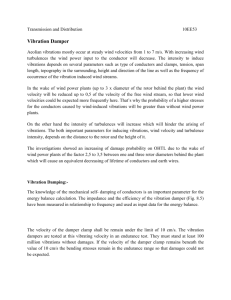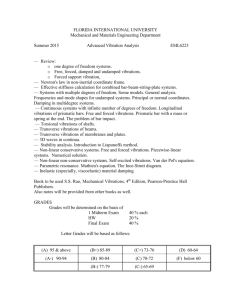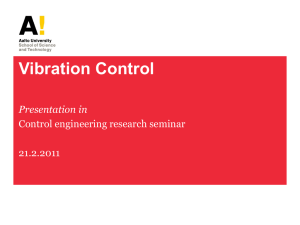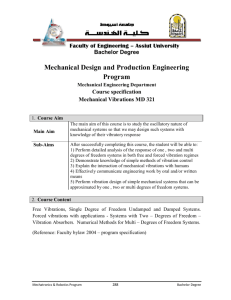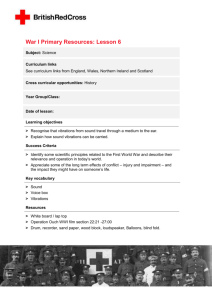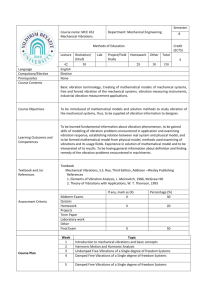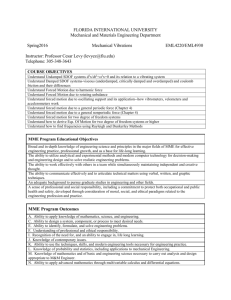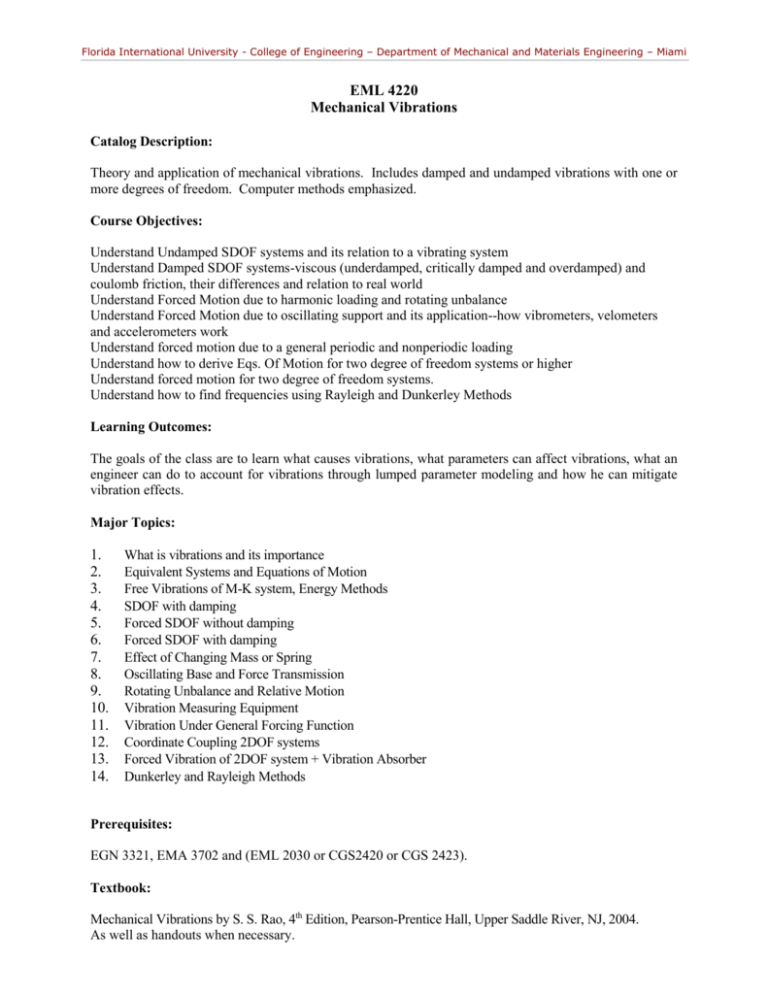
Florida International University - College of Engineering – Department of Mechanical and Materials Engineering – Miami
EML 4220
Mechanical Vibrations
Catalog Description:
Theory and application of mechanical vibrations. Includes damped and undamped vibrations with one or
more degrees of freedom. Computer methods emphasized.
Course Objectives:
Understand Undamped SDOF systems and its relation to a vibrating system
Understand Damped SDOF systems-viscous (underdamped, critically damped and overdamped) and
coulomb friction, their differences and relation to real world
Understand Forced Motion due to harmonic loading and rotating unbalance
Understand Forced Motion due to oscillating support and its application--how vibrometers, velometers
and accelerometers work
Understand forced motion due to a general periodic and nonperiodic loading
Understand how to derive Eqs. Of Motion for two degree of freedom systems or higher
Understand forced motion for two degree of freedom systems.
Understand how to find frequencies using Rayleigh and Dunkerley Methods
Learning Outcomes:
The goals of the class are to learn what causes vibrations, what parameters can affect vibrations, what an
engineer can do to account for vibrations through lumped parameter modeling and how he can mitigate
vibration effects.
Major Topics:
1.
2.
3.
4.
5.
6.
7.
8.
9.
10.
11.
12.
13.
14.
What is vibrations and its importance
Equivalent Systems and Equations of Motion
Free Vibrations of M-K system, Energy Methods
SDOF with damping
Forced SDOF without damping
Forced SDOF with damping
Effect of Changing Mass or Spring
Oscillating Base and Force Transmission
Rotating Unbalance and Relative Motion
Vibration Measuring Equipment
Vibration Under General Forcing Function
Coordinate Coupling 2DOF systems
Forced Vibration of 2DOF system + Vibration Absorber
Dunkerley and Rayleigh Methods
Prerequisites:
EGN 3321, EMA 3702 and (EML 2030 or CGS2420 or CGS 2423).
Textbook:
Mechanical Vibrations by S. S. Rao, 4th Edition, Pearson-Prentice Hall, Upper Saddle River, NJ, 2004.
As well as handouts when necessary.
Florida International University - College of Engineering – Department of Mechanical and Materials Engineering – Miami
EML 4220
Mechanical Vibrations
Program Educational Objectives:
Show the program objectives that are directly supported by this course and briefly describe how
each objective is achieved relative to course topics and practices employed in the course.
Mechanical & Materials Engineering Program
Educational Objectives
1. Broad and in-depth knowledge of
engineering science and principles in
the major fields of Mechanical
Engineering for effective engineering
practice, professional growth, and as a
base for life-long learning.
2. Hands-on experience with state-of-theart instruments and laboratory
techniques to bridge classroom learning
with practical, “real-life” problems.
3. The ability to utilize analytical and
experimental methods and modern
computer technology for decisionmaking and engineering design and to
solve realistic engineering problems.
4. The ability to work effectively with
others in a team while simultaneously
maintaining independent and creative
thought.
Mark X if
Applies
Description
x
Understand the concept of lumped
parameter analysis to represent a system as
a set of masses, springs and dampers to
evaluate the vibration characteristics of the
system. We make it very clear during the
course that life-long learning is important
from a professional standpoint.
x
Use computers to obtain solutions for
systems in which the external forcing
function is non-periodic
5. The ability to communicate effectively
and to articulate technical matters using
verbal, written, and graphic techniques.
x
6. An adequate background to pursue
graduate studies in engineering and
other fields.
x
7. A sense of professional and social
responsibility, including a commitment
to protect both occupational and public
health and safety, developed through
consideration of moral, social, and
ethical paradigms related to the
engineering profession and practice.
x
Homeworks and quizzes will be used to
evaluate effective communication of written
and graphic techniques.
Student
questions/answers will be used to evaluate
verbal communications.
This course is a pre-requisite to the graduate
level advanced mechanical vibration
analysis. So it will provide an adequate
background for those interested in
vibrations and vibration attenuation.
We discuss the ideas of vibration
attenuation and how that is important in
mechanical systems. We discuss the role of
ME’s in the design process and that part of
the process is recommendation making. We
discuss the professional engineer and what
his responsibilities are during the course.
Florida International University - College of Engineering – Department of Mechanical and Materials Engineering – Miami
EML 4220
Mechanical Vibrations
Program Educational Outcomes:
Show the program outcomes that are directly achieved by this course and describe how each
outcome is achieved in terms of specific tools employed in the course.
Mechanical & Materials Engineering Program
Educational Outcomes
a. Ability to apply knowledge of mathematics,
science, and engineering.
Mark X if
Applies
Description
x
Students learn to derive equations that govern
vibrations using their dynamics and differential
equations background.
x
They learn to use damping and vibration
absorbers as two means of designing systems
for vibration attenuation
b. Ability to design and conduct experiments,
as well as to analyze and interpret data.
c. Ability to design a system, component, or
process to meet desired needs.
d. Ability to function on multi-disciplinary
teams.
e. Ability to identify, formulate, and solve
engineering problems.
x
f. Understanding of professional and ethical
responsibility.
x
g. Ability to communicate effectively.
x
Students derive lumped parameter models that
model real systems and obtain the vibration
characteristics of such systems
Students learn of disasters that have occurred
due to vibrations and what our professional
responsibilities are vis-à-vis these kind of
problems
Students learn to do a better job on homeworks,
quizzes, etc. to communicate what they were
trying to achieve.
h. Broad education necessary to understand the
impact of engineering solutions in a global
and societal context.
i. Recognition of the need for, and an ability to
engage in, life long learning.
x
j. Knowledge of contemporary issues.
x
k. Ability to use the techniques, skills, and
modern engineering tools necessary for
engineering practice.
x
Students become aware of the need to engage in
life-long learning as real life systems require
more complex modeling beyond the scope of
this course.
Issues with an engineering flavor that have been
in the headlines in the recent past and present
are understood by the student more fully.
Students will come out of the course armed with
the basic engineering tools to evaluation
vibration and make recommendations on how to
“fix” the vibrations problem.
l. Knowledge of probability and statistics,
including applications to Mechanical
Engineering.
m. Knowledge of mathematics and of basic and
engineering science necessary to carry out
analysis and design appropriate to
Mechanical Engineering.
x
Students will have learned to model equivalent
mass, springs and dampers to represent physical
systems, solved the equations generated by this
lumped parameter analysis and evaluated the
results
for
the
purpose
of
making
recommendations.
n. Ability to apply advanced mathematics
through multivariable calculus and
differential equations.
x
Students will have solved ODEs
convolution integrals for displacements
and
Florida International University - College of Engineering – Department of Mechanical and Materials Engineering – Miami


